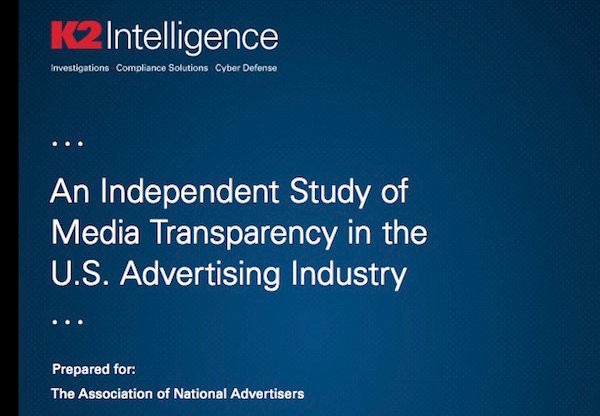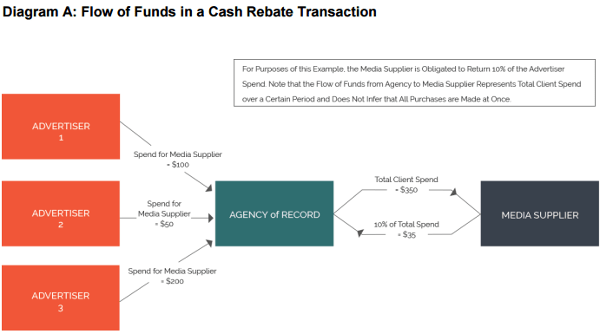Earlier this week, the investigative company K2 Intelligence, on behalf of the ANA, issued a report entitled ‘An Independent Study of Media Transparency in the U.S. Advertising Industry’. You can download the report here.
Industry speculation has been that the report would go some way to cementing wide-held beliefs about ‘non-transparent’ practices inherent in media agencies and their holding companies.
No pulling punches
For the naysayers, the report hasn’t disappointed. ‘Pervasive’ and ‘substantial’ were words used more than once to describe what the report termed as ‘non-transparent media practices’, across a broad range of areas.
The report focuses on the US market. Does that mean that these things do not happen here in Australia, or in other markets? Of course it doesn’t. The companies investigated by the report are global entities, with practices designed to maximise profit in all operating markets – which, let’s just say here, is largely the same for any global business, in any industry.
Furthermore, TrinityP3 observes via contractual assessment some of the practices outlined in the report when dealing with our own APAC based clients.
Stalemate-Gate?
The report is comprehensive and extremely well put together, in our opinion. But in a way, it exacerbates frustration caused by the apparent stalemate we all face.
Between marketers who blindly or intentionally misunderstand and fail to act on the issues, and media companies who, often contractually protected, do not wish to change their practices, everyone struggles to see the right way forward.
The report is great. But it doesn’t offer much in the way of actual solutions, because presumably that was not in scope. The solutions are basically implied, but with no guidance on how to execute them. Additionally, every piece of evidence it has generated has been under conditions of anonymity, which of course is understandable.
So we continue with the stalemate. People are, apparently, happy to talk off-record.
Publically, it’s a different story: the media companies, with no-one to actually coerce them and apparently little in the way of actual regulation in this area, largely continue either to refuse commentary, or to deny everything (something else that we see quite regularly, when asking questions).
This strategy also appears to be global. From Sir Martin Sorrell’s denouncement of the report,through to local Australian leads refusing to comment, the media industry is not exactly embracing the findings.
From the agency perspective, what supports such an approach is that anyone who has been in the business long enough knows that explosions in the transparency debate are not new. They’ve happened before, and they’ll happen again. So, ‘batten down the hatches and ride out the storm’ may seem attractive, in the circumstances.
The Report, Condensed
This report is thorough, and it’s technical. Even the Executive Summary is quite long. Here, in no ranking order, is my attempt to thematically categorise fifty six pages of densely populated text into four easy pieces:
1. The Role of the Client
This theme covers a range of areas, including contractual naiveté or negligence; lack of media market understanding; a focus on the trusting individual or day to day agency relationship at personal level, without proper contractual back-up; and implied exacerbation of non-transparent practices due to constant focus on cheap media rates and low fees.
2. The Power of the Holding Company
This theme demonstrates the contractual immunity, financial freedom and influencing power of Holding Companies, over their AOR’s (Agencies of Record). The Holding Company essentially dictates the operating patterns at group level; the individual agencies have no choice but to comply with orders which affect the integrity of the actual plan through to hidden fee mark-ups in the trading process.
The report also considered the power of Holding Companies in terms of equity stakes in media supplier networks.
3. The Variety of ‘Non Transparent’ Practices
This theme is built around the sheer number of ways in which the report defines ‘non-transparent’. Rebates in cash or free media, unbilled media holds, rebates structured as service provisions, lack of audit power via third-party contractual arrangements, programmatic mark ups, internal pressure applied to media buying teams, dual-ratecard practices… the report suggests a thorny network of brambles, very hard to unpick (the report uses the term ‘tapestry’).
4. The Role of the Media Owners
This theme concerns the various commentary made by Media Owners (the sales networks trying to get onto media schedules). Some appear to regard rebate-based deals as a cost of doing business; some seem to wilfully promote it; and some complain that they feel coerced by agencies to accept sharp practices or face dramatic drop-off in expenditure.
None of which, of course, places objectivity in media strategy and trading at the heart of the agency output.
What is TrinityP3’s view?
So is it true, or is it false?
It’s obviously simplistic to tarnish a whole industry with one big brush. It is also impossible from the report to understand who, exactly, may be allegedly guilty of such practices.
We also note that culpability in letting things get into this shape cannot be owned solely by one entity or part of the industry.
Finally, we state that at local agency level, in terms of the people on the ground doing their jobs (not just the junior ones, either), we see a lot of genuinely good intention, strong work and mutual respect.
We do not suggest for a second that ‘all agencies’ and their staff are fundamentally corrupt. We recognise that the majority of people who work in media agencies will have limited or zero understanding of how such practices are driven, or not driven, within their own companies.
But the evidence presented, albeit anonymous, cannot be ignored. We also have our own work in the field to give us further understanding.
Our conclusion, then, is that the report offers up serious concerns about the biggest advertising market in the world, the findings of which cannot fail to apply, in whole or in part, and in various shades of grey, to other markets around the world.
What can you do?
This is the hardest part. We are in a stalemate where, in my opinion, agencies can and do simply refuse to play ball with some client demands in this space, knowing full well that all of their competitors would do the same.
We also recognise, through our own work, that all clients are not the same. Some are more concerned about such things than others.
So let’s assume, for the sake of argument, that by reading this article, you identify as a CMO who wants a more transparent and balanced offering from your media agency.
Essentially, if you are this person, you’ll want to take steps to significantly increase the level of governance surrounding all media agency practices – something which, on all sides, has been missing for far too long.
Here are ten items to consider:
1. Get your contract checked out by independent experts in the field
Update it where necessary, regardless of a pitch.
2. If you have a financial audit clause in your contract – exercise it.
But remember it will only remedy in hindsight, there is work to do going forward.
3. When negotiating a new contract structure, after having had an industry-expert check, do not conduct it yourself or leave it to procurement
Ensure that you have proper legal counsel, who understand and are able to contractually articulate a proper Principal/Agent structure that generates a level of fiduciary responsibility for that agency. Use the UK based ISBA contractual template, released recently, as a start point/guide for your legal team.
4. Investigate and/or push for the development of contracts at Holding Company level, rather than at Agency level
This will increase your leverage at this critical level.
5. Put the issue of agency transparency on your board agenda
This is not necessarily something you can solve for yourself. You need the leverage of your business at senior level, particularly if dealing with Holding Company leads.
6. Do not assume that there are little or no alternatives to the diversified service offerings your agency puts in front of you.
Our work suggests, and the K2 report backs up, a sense that, in the programmatic trading space particularly, clients have signed contract addendums without fully understanding them, with a view that their agency’s ATD (agency trading desk) is the only option.
You can, and should, investigate market contest-ability in this area, to see if greater transparency and great product can combine to better effect elsewhere.
7. Stop making cheap media a stick to beat the agency with
Start putting proper performance KPIs in place that measure and reward against the value of the media, not the cost of it. As with the contract development itself – whilst procurement can play an important role, it should not be dictating KPI terms on the basis of cost alone.
8. Find compromise
The agency needs to be paid properly. Perhaps a compromise between sensible fee and increased transparency can be found in your particular relationship.
9. Give ‘media’ more respect as a whole
I noticed one commentator today stating that ‘advertising is the bum of the ant – the piece that comes in the rear after the vanguard decisions about product, pricing and distribution are made.
Media is still (unfortunately) a dimple on the bum of the ant – the bit that gets decided (usually) last.’ Well – as your largest single marketing cost centre, it’s one pretty damn big dimple. Treat it with the importance and diligence that such an investment deserves.
10.Don’t hide behind your ignorance
My experience suggests a tendency with some marketers to wilfully ignore areas like media because they do not want to raise an internal perception that they don’t understand it. We need to get over that dynamic and step over the parapet, otherwise nothing will change.
We hope that this summary helps you.
We hope that you can find a way that gets around Stalemate-gate and into a clearer future. We’re always happy to have a conversation with you, on a confidential basis, about ways in which we may be able to help you drive the best, most tailored solution for you.
TrinityP3’s Media Transparency, Performance and Value Assessment takes a holistic look at the operation of your media agency, assessing against best practice at every stage of the journey. It aims to give you the tools to improve the output of your media agency.
Why do you need this service? Click here to learn more






